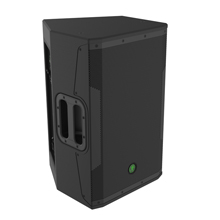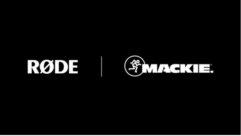

Manufacturers are working hard to advance portable speaker-on-a-stick technology, and among their designers’ goals are improved fidelity, roadworthiness, portability, and ease of use. Everybody wants high quality from easily moved and easily operated speakers that won’t fall apart.
It seems Mackie has been focused on finding a good balance of all of the above. The company now offers the SRM550, SRM650, and SRM1850—12in. and 15in. full-range speakers and an 18in. subwoofer, respectively. These are of a completely new design, substantially more modern than the venerable SRM450. I evaluated a pair of SRM1850s with stick-mounted SRM550s and discovered that these are not dad’s old early millennium Mackies.
Mackie marketing catchphrase for the series is “built like a tank,” and I agree. They’re surprisingly lightweight, considering their sturdy construction: 37lbs. and 64lbs., respectively, for the SRM550 and SRM1850. They’re made of Poplar plywood and internally braced. Contributing to the portability is the relatively modest cabinet size. The SRM550 is roughly 23”x14”x15” and the SRM1850 is roughly 22.5”x24”x 22”. They are nicely compact for a subwoofer with an 18in driver. Both cabinets are coated with heavy black paint and feature a recessed handle on each side. The SRM550 has three M-10 fly-points and an 18-gauge powder-coated steel grille. The SRM1850’s 16-gauge steel grille is more robust, and it has no fly points since Mackie essentially forbids flying it. It does, however, have a cup centered in its top panel for speaker-on-a-stick usage. It employs a ported enclosure topology, as is commonly the case with subwoofers, and the SRM550 does likewise.
The newest trend in portable self-powered speakers is the inclusion of onboard DSP, mixing, and more I/O than legacy products. Mackie is right at the front edge of that trend, as evidenced in its DLM series, which I reviewed here last year. The SRM series’ processing is not quite as sophisticated as that of the DLM, but it still adds functionality and simplifies the experience for end-users who are not audio pros. The SRM550 offers two input channels, the first of which is a jack that accepts either XLR or 1/4-balanced or unbalanced plugs. The second offers the same, along with a stereo pair of RCA jacks. Each input channel features a -∞dB to 50dB gain knob and a single LED that illuminates green as the input level reaches -20dBu and turns red as it nears clipping level. There is also an XLR “thru” output for daisy-chaining speakers. I like the versatility created by the pushbutton switch that determines whether the thru output passes along the signal from input 1 exclusively or a blend of both inputs.
An additional pushbutton switch advances through the SRM550’s four speaker modes to give the user four distinct EQ curves to improve the performance of the speaker in a handful of likely applications. PA mode is full range but focuses on midrange clarity, which is a starting-point setting and used particularly if there will be a lot of speech such as in business presentations and conferences. DJ mode is the traditional “disco smile” on the graphic EQ, boosting lows and highs for music playback. MON mode rolls off the lows and dips around 2kHz to facilitate more gain before feedback for floor-wedge applications. Finally, solo mode rolls off low end to reduce thumps and bumps and brightens the mids and highs to accentuate vocals and acoustic guitar brightness, which is ideal for singer-songwriters. The SRM550 also features Mackie’s Feedback Destroyer, with four 1/16-octave notch filters in seek-and-attenuate mode. Even if the SRM550 is not used as a floor wedge, this feature is still very helpful when the speaker is used as FOH. A Smart Protect limiter is also included to keep overzealous DJs and a band’s mix engineers in check.
The SRM1850 shares only the Smart Protect limiter in terms of signal processing and offers simple but effective bass management tools—namely, preset HPF cutoffs and predetermined alignment delay for SRM550 and SRM650 speakers available at the push of a button. There’s a third crossover option: continuously variable HPF cutoff frequency from 60Hz to 120Hz for use with other satellite speakers. A knob adjusts input sensitivity from -6dB to 6dB, and a pushbutton switch inverts input polarity for coarse time-alignment between sub and satellite speakers. There are two stereo pairs of outputs, one that simply passes along the input signal and one that presents a signal that’s been filtered based on the HPF settings. A pushbutton determines whether the full-range outputs pass along the stereo input of the speaker or a mono-summed blend of both.
I used these speakers in each of the four applications suggested by the four speaker modes and found them to be effective across the board. This is something that would have surprised me in similar loudspeakers even just a few years ago. While nearly all manufacturers have touted their portable self-powered speakers as useful in at least a couple of distinct applications, some have been better than others. Mackie’s pushbutton EQ not only simplifies speaker setup for non-pros, it is also truly effective at changing the characteristics of the speaker to make it perform better across the spectrum of its published array of applications. PA mode sounds very good for speech and effectively presents music as a background for speech or PowerPoint. With a competent FOH engineer, PA mode is probably the go-to mode for live music, putting EQ decisions completely in the hands of the mixer.
For music playback, DJ mode is excellent, delivering exactly what DJs typically request, loud with lots of low end. And the SRM1850 can deliver a lot of low end, particularly considering its size and weight. The DJ mode application in which I evaluated the system was a large school gymnasium with a stage, and the low end was sufficient to thrill the audience, cause concern among the chaperones, and draw a visit from the business owners across the five-lane street from the school. MON mode succeeds at helping to maximize gain before feedback, and delivers enough SPL to satisfy musicians. Solo mode is indeed great for coffee-shop-style artists, with one minor caveat: Many such guitarists play well enough to include a bass part with the lower strings, and low end is a bit more important to their sound than it is for others. Switching to PA mode or employing an SRM1850 to supplement the full-range speaker will largely resolve this issue.
Overall, the fidelity of these speakers is good, considering their price. By using a dolly, it’s possible for a single person to move and set up a simple SRM system. Additional complexity may require two people, but it is surprisingly portable and surprisingly lightweight, considering the sturdy construction of the enclosures. The amps are well matched with the drivers, which deliver substantial SPL with very little distortion. The easily operated pushbutton EQ curves truly make the speakers effective in four distinct applications, and the other DSP and simple mixing conventions add even more value. It’s obviously a trade-off to keep the price low, but the SRM series does not have as much DSP horsepower as its DLM counterparts; singer-songwriters would certainly benefit from the inclusion of reverb, but even lacking that, these speakers represent a very good value for a significantly broad range of applications.
PRODUCT SUMMARY
Pros: Copious SPL, great fidelity, very portable despite solid construction
Cons: The singer-songwriter application would benefit strongly from reverb
Applications: Public address, DJ, floor wedge monitoring, singer-songwriter
Price: $599.99 (SRM550); $899.99 (SRM1850)
SPECIFICATIONS
SRM550
Frequency response (–3dB): 55Hz – 17kHz; (–10dB): 4Hz – 20 kHz
Max peak SPL: 132dB
Crossover Point: 3kHz
Dispersion: 90º x 50º
High-Frequency Section
Voice coil diameter: 1.0in./25mm
Horn entry diameter: 1.4in./36mm
Diaphragm material: Titanium
Magnet material: Ferrite
Low-Frequency Section
Woofer diameter: 12.0in./305mm
Voice coil diameter: 2.6in./66mm
Diaphragm material: Paper
Magnet material: Ferrite
System Power Amplification
Rated power: 800W rms; 1600 watts peak
low/high Frequency Power Amplifier
Rated power: 400W rms; 800W peak
Rated THD: < 1%
Cooling: Convection
Design: Class D
SRM1850
Frequency response (–3dB): 40Hz – 120Hz
Frequency response (–10dB): 35Hz – 150Hz
Max peak SPL: 132dB
Crossover Point: 115Hz plus alignment delay [SRM550]; 115Hz plus alignment delay [SRM650]; 60Hz – 120Hz [Variable]
Slope: 3rd order HP, 4th order LP
Woofer diameter: 18.0in./457mm
Voice coil diameter: 3.0in./76mm
Subwoofer diaphragm material: Paper
Magnet material: Ferrite
Power amplifier rated power: 800W rms; 1600 watts peak
Rated THD: < 1%
Cooling: Convection
Design: Class D
John McJunkin is the principal of Avalon Podcasting in Chandler, Ariz., and produces and co-hosts a top-rated morning radio talk show in Phoenix, Ariz. He has consulted in the development of studios and installations and provides high quality podcast and voice production services.









